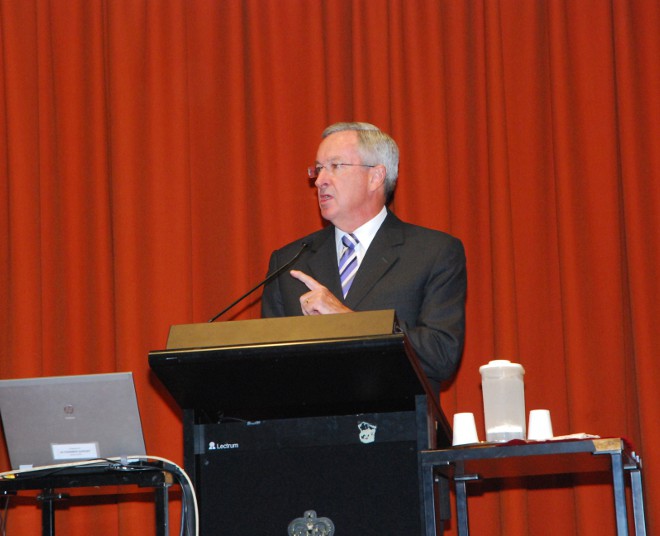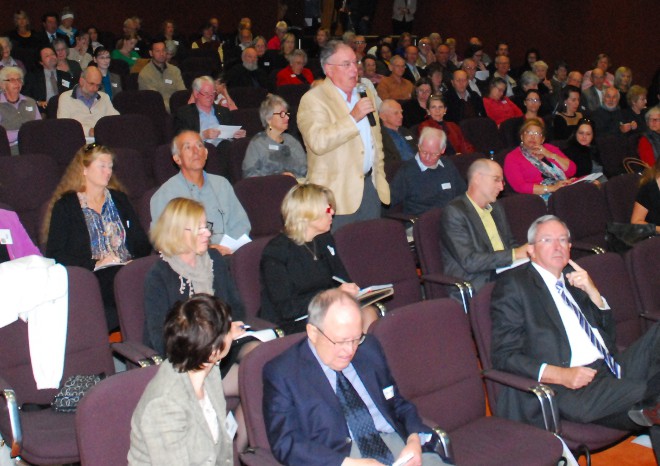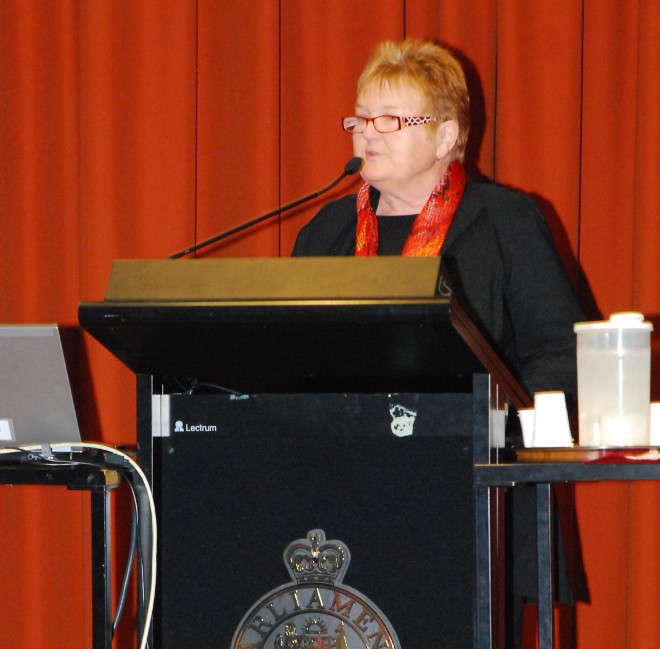BPN draws the heavyweights on NSW Planning
Even the audience was studded with the who’s who of town, with Sydney Lord Mayor Clover Moore making an appearance.
The tone of the forum was for the most part positive and constructive. Better Planning Network convenor Corinne Fisher stated that planning was too critical an issue to be bound by politics. Dr Wendy Sarkissian said she wouldn’t have bothered coming if she thought the minister wasn’t open to ideas on planning reform.
- See an article based on a presentation delivered by Dr Sarkissian to Harvard University: Wendy Sarkissian on NIMBYism, community resistance and housing density
The crux of the issue is that Sydney will need to accommodate 1.3 million more people by 2031. More houses need to be built, and if it’s to be done in a sustainable fashion, it means higher densities for existing areas.
The government states that planning reforms aim to balance this need with the needs of the community, the environment and the economy. But has the right balance been struck? According to the speakers (aside from minister Hazzard and Marcus Ray) and a sometimes unsettled audience, it’s a resounding no.
Concern mainly focused on the removal of appeal rights for community on site-specific developments, the watered down wording of sustainable development ideals in the legislation, the range of discretionary powers the minister would have, and the perceived weakness of community engagement.

Planning minister Brad Hazzard
The government speakers repeatedly assured the audience that it was still listening to the community and open to debate.
First up was planning minister Brad Hazzard, who admitted planning reform was going to be “a challenge”, but the current 30-year-old system wasn’t delivering.
Hazzard said the government was seriously committed to the community.
“Normally when a government in the Westminster system gets to the white paper stage it’s all go,” he said. “We took the decision as government that this is so important that we would also continue consultation at the white paper stage.
“We are doing what governments generally don’t do: we’re consulting to the nth degree.
“We are genuinely open to consideration.”
Hazzard said that two-thirds of the 545,000 houses needed are “for our kids”. He stated that his system would protect the environment, protect heritage and allow for intergenerational equity.
“I know it’s a challenge because people often don’t switch on to these issues until it’s happening right next door,” said Mr Hazzard, echoing the sentiments of BPN.
But he pointed to Vancouver, saying that one in four people there had been involved in strategic planning.
“We have to find a way to outreach to as many different people as we can,” he said.
How that will happen is yet to be properly elucidated.

Community members voice concern about planning reforms
Next up was executive director planning reform Marcus Ray, whose “potted history” of planning reform and roundabout answers to an increasingly fed-up audience went down like a lead balloon.
His position of having to defend the reforms as they stood was not enviable, and he was unable to offer any certainty to audience concern, only noting that the conversation was still open. “We are on a journey; this is not the end,” he said, as his body language became increasingly guarded.
“Poor, poor Marcus,” whispered another of the speakers during his question and answer session.
Mr Ray did, however, provide some comfort by saying that site-specific factors would come into play regarding whether a development would be code assessable, and therefore not able to be scrutinised by the community.
“They will always be site specific factors,” he said. “If it’s environmentally sensitive land it’s very unlikely that code assessment will be the assessment track.
“Having a pub in a residential area would never be code assessable.”
The most contentious issue of the day was undoubtedly the removal of community objection to code assessable developments.
Fielding a question of why developers had objection rights yet community did not, Mr Ray said, “The community and the developers are equal,” which was met with a chorus of groans.
“It’s not a question of appeals rights; it’s a question of engaging,” he said. “We can’t keep having those site-specific wars.”

John Mant
It’s 1979 all over again
City of Sydney councillor John Mant came next, with the valuable experience of having developed planning systems in “three or four other states”.
He called his speech “1979 rebadged?” because he thought the new planning system had largely been kept. As a lawyer, Mant provided some unique insight into how the legislation had been drafted and how it reflected a particular ideology.
“It’s important to grasp the ideology present in the legislation,” he said. “Sometimes the legislation is written in such a way that it can only really be driven in one direction.”
Mant said we should be concerned by the “range of discretions” in the legislation.
“The state has had ministers for planning and premiers who have made what I would call not impartial decisions under the planning system,” he said.
He also showed concern regarding strategic planning and the weakness of language around environmental and social considerations.
The first strategic planning principles states: “Strategic plans should promote the State’s economy and productivity through facilitating housing, retail, commercial and industrial development and other forms of economic activity, having regard to environmental and social considerations.”
“We should be concerned by the ‘range of discretions’ in the legislation.”
It is the “having regard to” part that concerns Mant.
“We lawyers know that ‘having regard to’ means you have regard to it and then you pass by the other side,” he said. “It has a very clear meaning. I know this because I wrote a planning act in South Australia.
“Within a year or two the Supreme Court said, ‘Well, that means you can ignore it.’ So we had to strengthen those words very considerably in the Act.”
He also showed concern regarding Principle 10, which states: “Local plans should facilitate development that is consistent with agreed strategic planning outcomes and should not contain overly complex or onerous controls that may adversely impact on the financial viability of proposed development.”
“I find this a pretty extraordinary section,” he said. “The purpose of development controls is to affect financial viability.
“Legally it’s a nonsense sentence but it reflects some of the ideology present in the legislation.”
“‘Having regard to’ means you have regard to it then you pass by the other side.”
He also described as “disturbing” the fact there is no legal consequences if the provisions of the legislation regarding community participation is not followed. The whole community participation process is not mandatory except for the requirement to give notice, which is the current requirement.

Dr Wendy Sarkissian
These people are not going away – Wendy Sarkissian
A breath of fresh air to many in the audience was final speaker Dr Wendy Sarkissian, an independent planning consultant and an expert on community engagement. Sarkissian brought experience in psychology and community development to try to understand why community groups have been so vocal in their opposition to the proposed reforms.
“What the government needs to listen to here is what home means to people,” she said.
Dr Sarkissian described people as animals hard-wired to protect their territories.
“Home is the territorial core. It’s where we’re attached as animals to our place.”
She said that she knew from 45 years of working in planning and community engagement that “the BPN and their colleagues are not going away” and it was in the interest of the government to listen.
“Why the great rush?” she asked. “I think that time is money. But not in the way you’d imagine it. Giving people time will ultimately save money.”
Resident activism can stop projects dead in the tracks, she said, saying that afterwards trust can never be rebuilt.
“The expense of delays brought about by extra-statutory protest will be massive.”
Sarkissian said she didn’t believe the community engagement strategy being proposed by the government was “leading practice”.
“I’d be convening a group of the wise engagement specialists and sitting down and looking at how the principles of inclusion could inform the next stages,” she said. “We have the best community engagement practitioners and planners in the world. I’d like to see them involved in this conversation.”
The Vancouver model has failed
She also noted that the oft-referred to Vancouver model was not where we should be looking.
“I’m here to tell you they’re not the answer to our problems,” she said to applause. “Let’s get rid of this cultural cringe that we need to take our advice from outsiders.
“We don’t need Vancouver. Vancouver fails as a model on scale, on culture, on the money, on timing.”
We have to have higher density and we can make it work
When questioned by the audience on whether high-density housing was a necessary “ideology”, Sarkissian made it patently clear where she stood as an environmental ethicist.
“The living earth is in peril,” she said. “And human behaviour has caused some of these problems. And the valid and powerful underpinnings of this legislation are about trying to create a sustainable Sydney and a sustainable NSW. And sustainability is in everybody’s interest. I think we have to have higher density housing. I believe we can make it work. It doesn’t have to be grotesque; it doesn’t have to be high-rise necessarily. But underpinning this legislation is a basic biophysical reality about the state of the earth.
“I’m a density person. I’ve written award-winning books on higher-density housing. I’ve done a huge study of resident satisfaction and higher density housing in Vancouver.
“I’m not here to stop higher density housing.
“The BPN and their colleagues are not going away.”
“I’m here to have an informed public discussion about it, and I think if people could understand better the sustainability forces behind the government’s initiatives to increase density then we’d have a better conversation about it.
“I’m here for density; but I’m not here for density that’s poorly done, and I’m certainly not here for density that’s rammed down people’s throats.”
And, on a sustainability angle, this is the crux of the issue. We need higher density housing. But we also need community understanding and consent. Without perceived legitimacy, the government’s reforms will cause massive community unrest. And the brunt of this would be taken by local councils, whose doorsteps protests would be conducted on.
Where we go from here depends on if the government is serious about its commitment to effective community engagement or whether it’s simply talking the talk. Time will tell.
Photo credit: Izzy, Ipfoto
Also see ABC 7:30 Report - www.abc.net.au/news/2013-05-24/barangaroo-development-questions-nsw-planning/4712346


